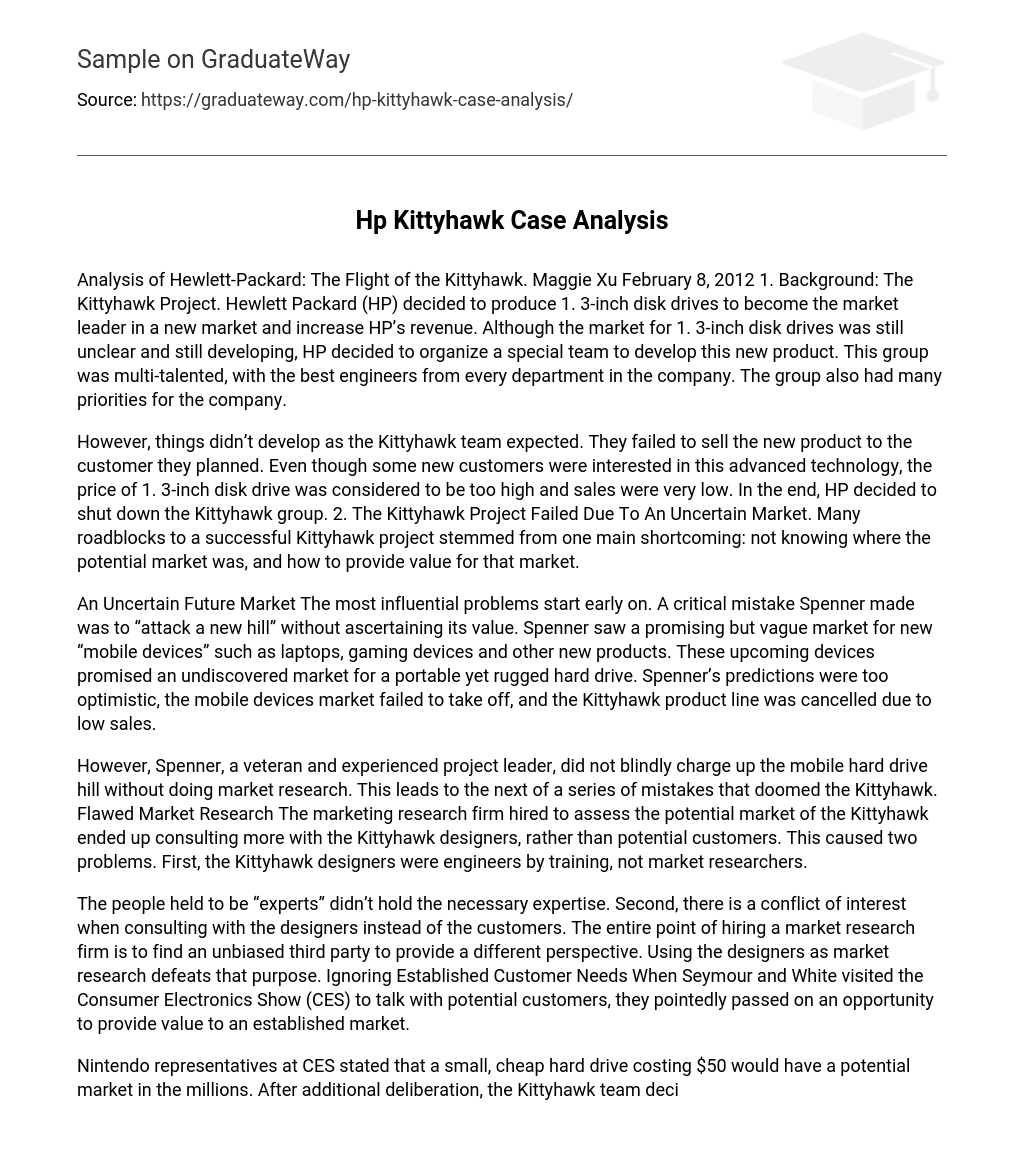Background: The Kittyhawk Project
Hewlett Packard (HP) decided to produce 1. 3-inch disk drives to become the market leader in a new market and increase HP’s revenue. Although the market for 1. 3-inch disk drives was still unclear and still developing, HP decided to organize a special team to develop this new product. This group was multi-talented, with the best engineers from every department in the company. The group also had many priorities for the company.
However, things didn’t develop as the Kittyhawk team expected. They failed to sell the new product to the customer they planned. Even though some new customers were interested in this advanced technology, the price of 1. 3-inch disk drive was considered to be too high and sales were very low. In the end, HP decided to shut down the Kittyhawk group.
The Kittyhawk Project Failed Due To An Uncertain Market
Many roadblocks to a successful Kittyhawk project stemmed from one main shortcoming: not knowing where the potential market was, and how to provide value for that market. An Uncertain Future Market The most influential problems start early on. A critical mistake Spenner made was to “attack a new hill” without ascertaining its value.
Spenner saw a promising but vague market for new “mobile devices” such as laptops, gaming devices and other new products. These upcoming devices promised an undiscovered market for a portable yet rugged hard drive. Spenner’s predictions were too optimistic, the mobile devices market failed to take off, and the Kittyhawk product line was cancelled due to low sales.
However, Spenner, a veteran and experienced project leader, did not blindly charge up the mobile hard drive hill without doing market research. This leads to the next of a series of mistakes that doomed the Kittyhawk. Flawed Market Research The marketing research firm hired to assess the potential market of the Kittyhawk ended up consulting more with the Kittyhawk designers, rather than potential customers. This caused two problems. First, the Kittyhawk designers were engineers by training, not market researchers.
The people held to be “experts” didn’t hold the necessary expertise. Second, there is a conflict of interest when consulting with the designers instead of the customers. The entire point of hiring a market research firm is to find an unbiased third party to provide a different perspective. Using the designers as market research defeats that purpose. Ignoring Established Customer Needs When Seymour and White visited the Consumer Electronics Show (CES) to talk with potential customers, they pointedly passed on an opportunity to provide value to an established market.
Nintendo representatives at CES stated that a small, cheap hard drive costing $50 would have a potential market in the millions. After additional deliberation, the Kittyhawk team decided to pass on this opportunity in search of more lucrative markets. This mistake is somewhat understandable, because the $50 target cost was deemed too high of a technological challenge. Investing in Uncertain Customers The last complication leading to the Kittyhawk projects demise came from the customers themselves. After the launch of the first Kittyhawk hard drive, many new unexpected customers stepped forward to show interest.
This situation became the proverbial carrot-on-a-stick for the Kittyhawk team. However, none of these customers provided sure sources of revenue by entering into contracts to purchase Kittyhawk hard drives. As time went on, the technical challenges were either not met, or the customer found different solutions to their problems.
Recommendations
It’s easy to misjudge market growth when technology is too far from maturity. Since the market was too nascent, the customers did not have stable requirements.
The late Steve Jobs stated that customers often are unaware of what they need until they are shown it. In this case, the potential Kittyhawk customers kept changing what they wanted, and the Kittyhawk team was left to follow(the blind following the blind). In the future, better predictions of potential markets are needed.
The following guidelines can be derived from the Kittyhawk project:
- It is safer to produce products for an established market rather than to invest in a developing market where the potential is unknown. Independent and unbiased market research should be conducted to provide an outside perspective.
- Find a real customer before investing in R&D, instead of only finding someone willing to cooperate. * Produce products that can be used in more devices. Avoid building niche products unless the niche market is certain.
- Know the cost limits of the product. Don’t produce products that the customer cannot afford.
References
- Clayton Christensen (2003), “Hewlett-Packard: The Flight of the Kittyhawk,” Harvard Business School (March), Case #9-697-060.





